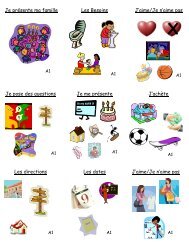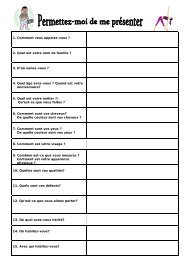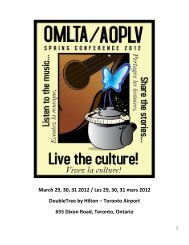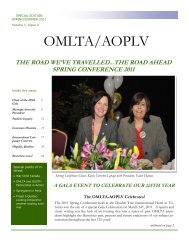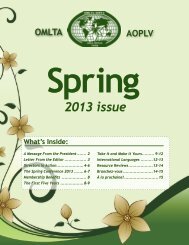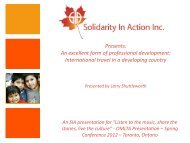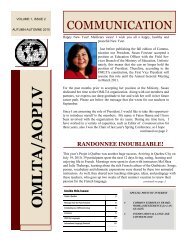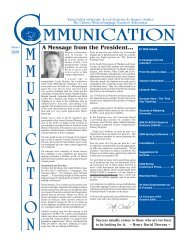2012 Issue - Ontario Modern Language Teachers
2012 Issue - Ontario Modern Language Teachers
2012 Issue - Ontario Modern Language Teachers
Create successful ePaper yourself
Turn your PDF publications into a flip-book with our unique Google optimized e-Paper software.
Resource<br />
Reviews<br />
e<br />
Talking to Learn<br />
50 Strategies for Developing<br />
Oral <strong>Language</strong><br />
Authors: Jennifer Glass,<br />
Joan Green and Kathy<br />
Gould-Lundy<br />
Those who know me and know about<br />
my curiosity and passion for early learning<br />
and developing language skills will<br />
smile in recognition when I share the<br />
opening quote in this marvelous work:<br />
“Reading and writing float on a sea of<br />
talk.”-James Britton. Jennifer, Joan<br />
and Kathy had me right there. Actually,<br />
they had me when I saw their names as<br />
authors; they had me at the title. With<br />
confidence that this would be a valuable<br />
resource for any educator working<br />
with students developing language<br />
skills, I began the page turner that does<br />
not disappoint. Please join me in an<br />
over-view of this work which recognizes<br />
and informs that “Oral language acquisition<br />
is a natural process for children of<br />
all languages and in all cultures.” (p 7)<br />
One of the things that Talking to Learn<br />
accomplishes for educators specifically<br />
of FSL, is the bridging of the professional<br />
learning and the professional<br />
conversation around student learning<br />
no matter what the language of instruction.<br />
“Talking to Learn roots student<br />
progress in collaboration and talk,<br />
recognizing these elements as vehicles<br />
by which students learn to explore,<br />
analyze, refine, and conclude.” (p 13)<br />
Elizabeth Coelho is quoted in chapter<br />
one with practical suggestions for guidance<br />
teachers can offer, particularly for<br />
ELL-English <strong>Language</strong> Learners. They<br />
make complete sense for students of<br />
FSL also.<br />
Elmore’s studies in education remind us<br />
that “we learn about the work by doing<br />
the work.” It seems reasonable, then,<br />
that a language is learned by using the<br />
language…rather than by learning about<br />
the language. The authors provoke<br />
thinking early on by raising: “It is a<br />
rather perverse irony that adults, and<br />
parents in particular, watch with awe<br />
and admiration as children learn to walk<br />
and talk. Yet, when these same children<br />
arrive in school, they are frequently<br />
expected to sit down and pay singleminded<br />
attention to adult talk!” (p 7)<br />
Having provoked our thinking, authors<br />
Jennifer Glass, Joan Green and Kathy<br />
Gould-Lundy support our next step<br />
instructional decisions with researched<br />
based, <strong>Ontario</strong> curriculum rooted strategies-50<br />
of them, in fact! The strength<br />
in this collection of 50 is the fact that<br />
they’re tried and true; strategies are<br />
clearly explained and accompanied<br />
by modeling of what does it look like/<br />
what does it sound like; including<br />
photographs, quotes, and a sprinkling of<br />
templates to support implementation.<br />
Talking to Learn prompts thinking and<br />
nurtures professional judgment in the<br />
following foundations:<br />
• Development of oral language as a<br />
precursor to literacy development for<br />
all students<br />
• Inclusive classrooms where all<br />
students benefit from dialogue and<br />
activity based on respect and<br />
reciprocity<br />
• <strong>Teachers</strong>’ powerful instructional<br />
insights and strategies to connect<br />
students’ interests and experiences<br />
• Encouragement for students as they<br />
learn to explain their thinking and<br />
share their feelings<br />
• Opportunities for use of a rich variety<br />
of technological resources to support<br />
student inquiry and engagement<br />
• Valuing the development of English<br />
language learners’ strengths in first<br />
language as support for developing<br />
proficiency of additional language.<br />
(p.9)<br />
Happy Reading! Bonne lecture! And best<br />
wishes for co-learning with students<br />
who are Talking to Learn.<br />
by Sharon McNamara-Trevisan<br />
Branchez-vous<br />
e 17<br />
Open Doors...Open Minds /<br />
Portes ouvertes...<br />
Esprits ouverts!<br />
http://languagesopenthedoor.afmlta.<br />
asn.au/<br />
<strong>Language</strong>s Open the Door to a Bigger<br />
World – this site offers the following<br />
links in order to investigate languages:<br />
Promotional Materials, <strong>Language</strong>s Advocacy,<br />
<strong>Language</strong>s Champions, Supporter<br />
Organisations, About the Project.<br />
Why It’s Smart to Be Bilingual – read<br />
this article published in Newsweek April<br />
2011.<br />
http://www.thedailybeast.com/newsweek/2011/08/07/why-it-s-smart-tobe-bilingual.html<br />
http://www.llas.ac.uk/resourcedownloads/6063/700_reasons.pdf<br />
Seven hundred reasons for studying<br />
languages by Angela Gallagher-Brett<br />
from <strong>Language</strong>s Linguistics Area Studies<br />
(LLAS).<br />
http://www.cbc.ca/news/canada/<br />
story/<strong>2012</strong>/01/03/f-vp-ross-language.<br />
html<br />
The secret to learning languages – Tips<br />
from the polyglots: Find out how your<br />
brain works by Colleen Ross, CBC News<br />
posted Jan 3, <strong>2012</strong>.<br />
http://www.omniglot.com/language/<br />
index.htm<br />
<strong>Language</strong> learning tips contains a collection<br />
of advice, suggestions, tips and<br />
techniques for learning languages.



